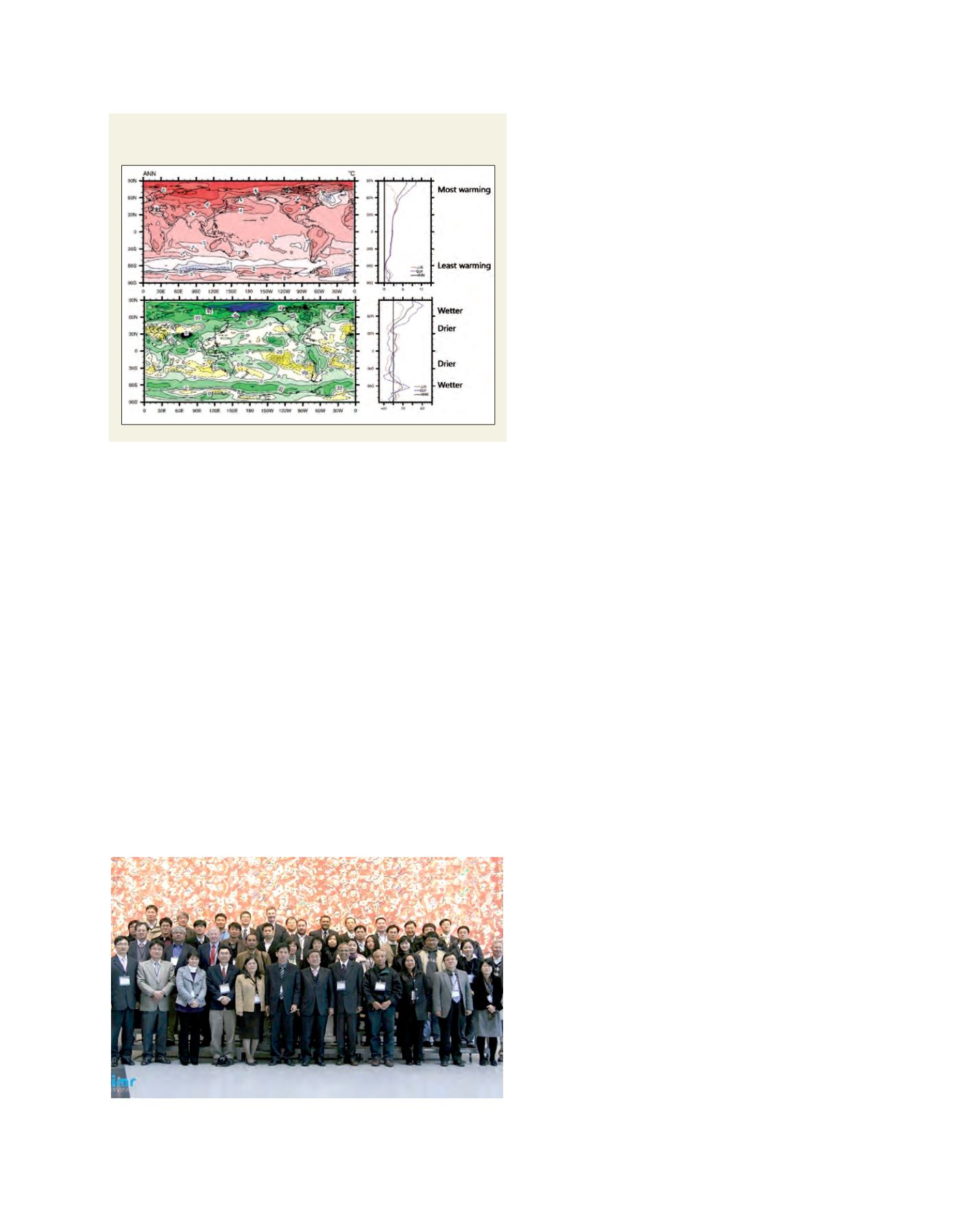

[
] 188
O
bserving
, P
redicting
and
P
rojecting
C
limate
C
onditions
an increased risk of extreme rainfall events in the
summer. The daily maximum temperature in the
summer and daily minimum temperature in the
winter is projected to increase by 3.8
o
C and 5.3
o
C
respectively. While results from dynamic downs-
caling are more skillful and sophisticated than ever
before, a key caveat is that there exists significant
uncertainty for regional climate scenarios. To reduce
the uncertainty, further research is needed.
The CRL provides regular 3-month forecast data
to KMA and the APEC Climate Center using the
Global Data Assimilation and Prediction System –
an AGCM developed by KMA. Recently, through
the Joint Program for Unified Model Collaboration
with the UK Hadley Centre, the CRL is planning to
provide 3-month ensemble forecast with the UK Met
Office. As a result of the collaboration, development
and production of 12-month forecast data by 2012 is
also in the works.
The CRL earth system model project was launched
in 2008 in order to better understand and predict
climate change and variability by improving the
current global model. The project, in its initial stage,
has completed construction of a coupled atmosphere-
ocean-sea ice model, using the OASIS coupler, UM,
and MOM4. Future plans include the development of
an integrated earth system framework – combining a
terrestrial module, an aerosol module, and a carbon
cycle and sulfate module – by 2012.
The understanding of climate science and the
quality of climate information has seen dramatic
progress of late. With information on climate change
gaining more exposure, society has come to realize its
potential importance. By tailoring available climate
information to the general public, end-users with
specific needs, and various sectors of society, the CRL
is improving the societal usefulness of climate infor-
mation. The CRL provides a wide range of climate
change and forecast information, as well as infor-
mation about climate science, to the Korean public
through the Korean Climate Change Information
Center.
1
The CRL has also provided climate change
scenarios and information to Korean government
organizations for their assessment reports, including
the Mitigation and Adaptation Plan from the Ministry
of Environment and Impact Assessment of the Impact
of Climate Change on the Agricultural Sector, by the
Korea Rural Economic Institute.
The CRL has been active in outreach programmes to
raise the awareness of the Korean public. Although the
mission of the CRL is to further the scientific under-
standing of the climate system, it also understands the
social responsibilities and roles of scientists in inform-
ing the public and decision makers about climate
change. In addition to publishing articles in peer-
reviewed academic journals, the CRL also works with
various media outlets including magazines, newspapers,
television and radio, providing climate change science
and information. The CRL also offers presentations
model developed by MPIM. Time-slice experiments using a high-
resolution Atmospheric Global Climate Model (AGCM) suggest
that weakening of the North Pacific jet stream will occur by the
late 21st century due to global warming. The change in the jet
stream appears to be due to the decrease in latitude tempera-
ture over the Asian continent, as well as eddy activity. The same
experiment found that while the frequency of tropical cyclones
over the northwest Pacific Ocean decreases, the intensity of tropi-
cal cyclones is likely to increase.
To project regional climate change over Korea, scenarios
were generated by the CRL through dynamic downscaling using
SRES A1B and the MM5 regional models. Downscaled data was
obtained by simulating years 1971-2100 with a spatial reso-
lution of 27 kilometres. The findings show that by the end of
the 21st century, the mean surface temperature over Korea is
projected to increase by 3.8
o
C, and as much as 4.5
o
C at 400hPa.
Hot days and cold days exceeding the 95th percentile of climatic
average will increase fivefold and decrease 99 per cent respec-
tively. Precipitation is projected to increase 17 per cent, with
Climate projection using the ECHO-G model based on
the IPCC SRES A1B Scenario
Source: National Institute of Meteorological Research (NIMR) in KMA
International Conference on Climate Change Science and Impacts
19-22 November 2008, International Convention Center, Jeju, Korea
Image: NIMR
















